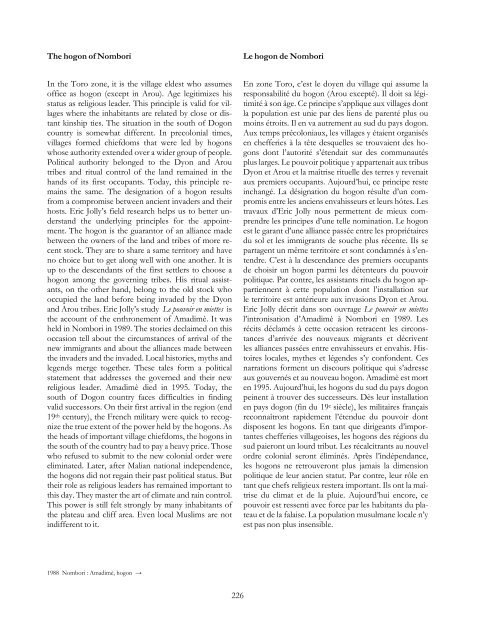Dogon - Images and Traditions
Create successful ePaper yourself
Turn your PDF publications into a flip-book with our unique Google optimized e-Paper software.
The hogon of Nombori<br />
Le hogon de Nombori<br />
In the Toro zone, it is the village eldest who assumes<br />
office as hogon (except in Arou). Age legitimizes his<br />
status as religious leader. This principle is valid for villages<br />
where the inhabitants are related by close or distant<br />
kinship ties. The situation in the south of <strong>Dogon</strong><br />
country is somewhat different. In precolonial times,<br />
villages formed chiefdoms that were led by hogons<br />
whose authority extended over a wider group of people.<br />
Political authority belonged to the Dyon <strong>and</strong> Arou<br />
tribes <strong>and</strong> ritual control of the l<strong>and</strong> remained in the<br />
h<strong>and</strong>s of its first occupants. Today, this principle remains<br />
the same. The designation of a hogon results<br />
from a compromise between ancient invaders <strong>and</strong> their<br />
hosts. Eric Jolly’s field research helps us to better underst<strong>and</strong><br />
the underlying principles for the appointment.<br />
The hogon is the guarantor of an alliance made<br />
between the owners of the l<strong>and</strong> <strong>and</strong> tribes of more recent<br />
stock. They are to share a same territory <strong>and</strong> have<br />
no choice but to get along well with one another. It is<br />
up to the descendants of the first settlers to choose a<br />
hogon among the governing tribes. His ritual assistants,<br />
on the other h<strong>and</strong>, belong to the old stock who<br />
occupied the l<strong>and</strong> before being invaded by the Dyon<br />
<strong>and</strong> Arou tribes. Eric Jolly’s study Le pouvoir en miettes is<br />
the account of the enthronement of Amadimè. It was<br />
held in Nombori in 1989. The stories declaimed on this<br />
occasion tell about the circumstances of arrival of the<br />
new immigrants <strong>and</strong> about the alliances made between<br />
the invaders <strong>and</strong> the invaded. Local histories, myths <strong>and</strong><br />
legends merge together. These tales form a political<br />
statement that addresses the governed <strong>and</strong> their new<br />
religious leader. Amadimè died in 1995. Today, the<br />
south of <strong>Dogon</strong> country faces difficulties in finding<br />
valid successors. On their first arrival in the region (end<br />
19 th century), the French military were quick to recognize<br />
the true extent of the power held by the hogons. As<br />
the heads of important village chiefdoms, the hogons in<br />
the south of the country had to pay a heavy price. Those<br />
who refused to submit to the new colonial order were<br />
eliminated. Later, after Malian national independence,<br />
the hogons did not regain their past political status. But<br />
their role as religious leaders has remained important to<br />
this day. They master the art of climate <strong>and</strong> rain control.<br />
This power is still felt strongly by many inhabitants of<br />
the plateau <strong>and</strong> cliff area. Even local Muslims are not<br />
indifferent to it.<br />
En zone Toro, c’est le doyen du village qui assume la<br />
responsabilité du hogon (Arou excepté). Il doit sa légitimité<br />
à son âge. Ce principe s’applique aux villages dont<br />
la population est unie par des liens de parenté plus ou<br />
moins étroits. Il en va autrement au sud du pays dogon.<br />
Aux temps précoloniaux, les villages y étaient organisés<br />
en chefferies à la tête desquelles se trouvaient des hogons<br />
dont l’autorité s’étendait sur des communautés<br />
plus larges. Le pouvoir politique y appartenait aux tribus<br />
Dyon et Arou et la maîtrise rituelle des terres y revenait<br />
aux premiers occupants. Aujourd’hui, ce principe reste<br />
inchangé. La désignation du hogon résulte d’un compromis<br />
entre les anciens envahisseurs et leurs hôtes. Les<br />
travaux d’Eric Jolly nous permettent de mieux comprendre<br />
les principes d’une telle nomination. Le hogon<br />
est le garant d’une alliance passée entre les propriétaires<br />
du sol et les immigrants de souche plus récente. Ils se<br />
partagent un même territoire et sont condamnés à s’entendre.<br />
C’est à la descendance des premiers occupants<br />
de choisir un hogon parmi les détenteurs du pouvoir<br />
politique. Par contre, les assistants rituels du hogon appartiennent<br />
à cette population dont l’installation sur<br />
le territoire est antérieure aux invasions Dyon et Arou.<br />
Eric Jolly décrit dans son ouvrage Le pouvoir en miettes<br />
l’intronisation d’Amadimè à Nombori en 1989. Les<br />
récits déclamés à cette occasion retracent les circonstances<br />
d’arrivée des nouveaux migrants et décrivent<br />
les alliances passées entre envahisseurs et envahis. Histoires<br />
locales, mythes et légendes s’y confondent. Ces<br />
narrations forment un discours politique qui s’adresse<br />
aux gouvernés et au nouveau hogon. Amadimè est mort<br />
en 1995. Aujourd’hui, les hogons du sud du pays dogon<br />
peinent à trouver des successeurs. Dès leur installation<br />
en pays dogon (fin du 19 e siècle), les militaires français<br />
reconnaîtront rapidement l’étendue du pouvoir dont<br />
disposent les hogons. En tant que dirigeants d’importantes<br />
chefferies villageoises, les hogons des régions du<br />
sud paieront un lourd tribut. Les récalcitrants au nouvel<br />
ordre colonial seront éliminés. Après l’indépendance,<br />
les hogons ne retrouveront plus jamais la dimension<br />
politique de leur ancien statut. Par contre, leur rôle en<br />
tant que chefs religieux restera important. Ils ont la maîtrise<br />
du climat et de la pluie. Aujourd’hui encore, ce<br />
pouvoir est ressenti avec force par les habitants du plateau<br />
et de la falaise. La population musulmane locale n’y<br />
est pas non plus insensible.<br />
1988 Nombori : Amadimè, hogon →<br />
226
















